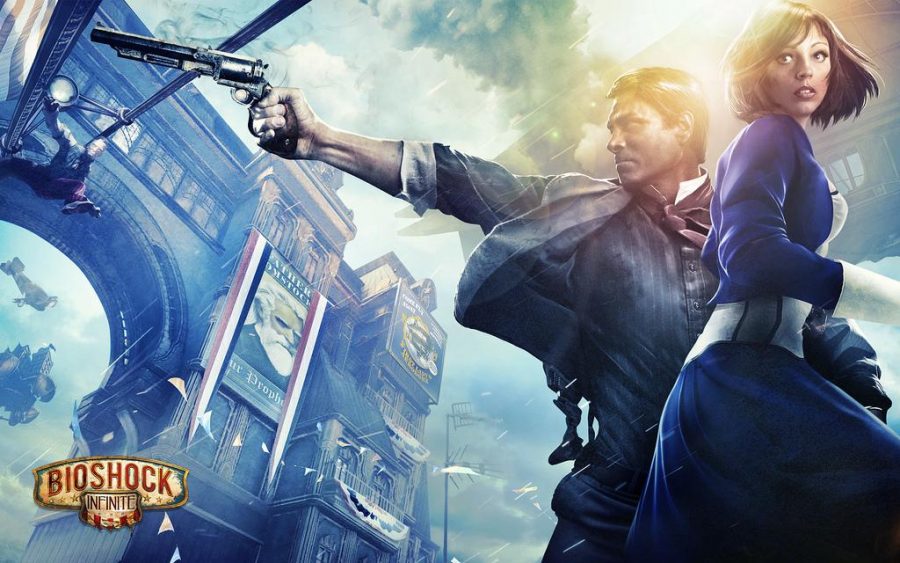1912 Coast of Maine:
Booker Dewitt sits in the back of a small rowboat headed somewhere unknown to him. The two people rowing Booker to his destination are talking amongst themselves, oddly never addressing him directly. One of them hands Dewitt a box. Inside is a gun, a postcard from somewhere called Columbia and a photo of his target, Elizabeth. “Bring us the girl and wipe away the debt.”
“BioShock Infinite,” the third and final game in the in the “BioShock” series, was released in 2013 by Irrational and 2K games. The “BioShock” games are easy to identify. Most gamers know what a big daddy is, what Adam and Eve are and the story behind the phrase “would you kindly.”
The first game was set in Rapture, an underwater city where art and science are not held down by the iron fists of government. Inspired by books like “Atlas Shrugged” and “The Fountainhead” by Ayn Rand, the game explores objectivism, government regulation and class divisions.
Opposite to this is Columbia, the city where “BioShock Infinite” takes place, which is miles in the sky, floating high above the world. Founded by Comstock the Prophet, this city secedes from the union after the civil war and becomes its own country.
“BioShock Infinite” bites off a lot for the proverbial “Meat of Theory” and has several areas of American exceptionalism brought to question. It dives into topics such as racism, economic inequality, class, the white man’s burden, rewriting history, brainwashing youth, industry, religion versus science, fate and choice and quantum mechanics.
Now, this is a lot to digest, but stay with me here.
“BioShock Infinite” is a first-person shooter with two main mechanics: your guns and vigors. When it comes to your loadout of weapons, you start with a pistol but eventually gain access to shotguns, sniper rifles and RPG’s which are readily available due to Columbia’s commerce, where guns can be bought anywhere.
When it comes to melee, you get something called the skyhook, which helps you both dispatch your foes, and get around on Columbia’s skylines, a monorail-style transport system for cargo. Vigors, on the other hand, are like magic, giving you the power to summon a swarm of ravens or toss your enemies high into the air. They are produced by the Fink company and are this games variant on plasmids from the original “BioShock.”
Everything is intuitive, combos are easy to pull off and you never feel starved for ammo thanks to your companion, Elizabeth. After you find Elizabeth on Monument Island, she follows you along, helping you find secrets, gather supplies and even opening tears in the universe. Tears are described as doorways that show you glimpses into other universes, even passing through time. It’s an interesting mechanic that mingles with the plot seamlessly, also affecting the soundtrack.
In a time where we want our choices to matter in our games, in this one instance, your choices have no impact on the story. This is one of the beautiful aspects of this game. It’s making a statement about fate.
So, do our choices matter at all? Are we destined to our fate the day we are born? Or with every choice we make, do more and more universes get created?
I give this game an 8.5 out of 10.
The game is a great social commentary in an interesting world with characters you can relate to. Everyone and everything has a motive, the city changes drastically as you play and has fun, easy to learn mechanics.
This game was well received by critics, but fans of the series weren’t quite as happy. I personally didn’t play the first games, but I love “Bioshock Infinite” and so do all the people I’ve talked to who have only played “Bioshock Infinite.”
The plot can get confusing, but if you won’t feel that way if you are diligent.
March 26 marked its five-year anniversary. You can buy “BioShock Infinite” used at some stores or online wherever games are sold. I would suggest Steam for PC and Mac, but on a console, the Remastered “BioShock” collection was released for PlayStation 4 and Xbox One in late 2016.
m.falkner@dailyutahchronicle.com
@TheChrony


